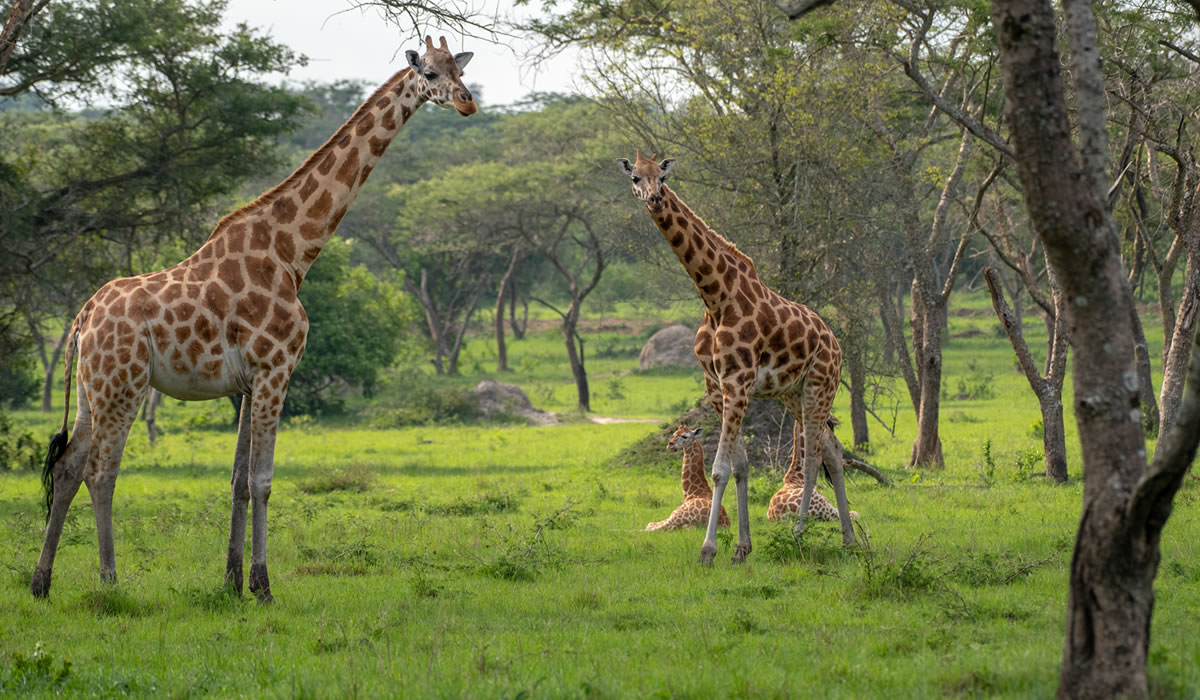Lake Mburo National Park may be the smallest of Uganda’s savannah national parks, but it offers an impressive variety of attractions and activities that rival even its larger counterparts. Located in the western part of Uganda, between the towns of Masaka and Mbarara, the park spans approximately 370 square kilometers and is named after the largest of its five lakes; Lake Mburo. This compact yet biodiverse park is characterized by rolling hills, open savannah, acacia woodlands, and rich wetlands, offering a tranquil retreat into the wild with fewer crowds and a more intimate safari experience.
What makes Lake Mburo particularly special is its accessibility, proximity to Kampala, and its unique mix of wildlife and scenery, offering everything from walking safaris and cycling tours to boat rides and birdwatching. Whether you’re looking for a peaceful getaway, a stopover on a longer safari, or a weekend escape into nature, Lake Mburo National Park is a destination worth exploring.

Activities in Lake Mburo National Park
1. Game Drives
Game drives are the quintessential safari activity in Lake Mburo National Park and offer the best opportunity to explore its savannah landscapes. Though the park lacks some of the more famous big game species like elephants and lions, it is home to a rich diversity of other animals. These include zebras, impalas, eland, topi, buffaloes, warthogs, oribi, waterbucks, and giraffes introduced to the park in recent years from Kidepo Valley.
The Kigambira Loop and Zebra Track are particularly productive routes where visitors are almost guaranteed sightings of large herbivores and various bird species. Morning and late afternoon game drives are ideal when wildlife is most active.
2. Boat Safari on Lake Mburo
The tranquil waters of Lake Mburo offer a fantastic opportunity for a boat safari, which provides a different perspective on the park’s wildlife. During the boat ride, visitors can spot hippos cooling off in the water, Nile crocodiles basking along the banks, and numerous birds such as African fish eagles, pied kingfishers, malachite kingfishers, cormorants, and herons.
The boat cruise is especially popular among bird watchers and nature photographers. The presence of papyrus beds along the lake’s edge also attracts rare species like the papyrus gonolek.
3. Walking Safaris
One of Lake Mburo’s standout features is its permission of guided walking safaris, a rarity in Uganda’s national parks. These walks offer a more immersive experience, allowing visitors to track animals on foot, listen to the sounds of nature, and observe smaller details of the ecosystem that are often missed from a vehicle.
Led by experienced Uganda Wildlife Authority rangers, walking safaris typically begin in the early morning when temperatures are cooler and animals are more active. Walks may lead to popular viewpoints such as the Kazuma Hill, offering panoramic views over the park and its lakes.
4. Horseback Safaris
Unique to Lake Mburo National Park, horseback safaris provide a truly novel and exhilarating way to experience wildlife. Operated by Mihingo Lodge, these guided rides allow you to quietly approach animals without the noise of an engine, making it possible to observe zebras, antelopes, and giraffes at close range.
Both short rides and longer treks are available, catering to different experience levels. This activity is especially popular with families and adventurous travelers looking for an alternative safari experience.
5. Cycling Tours
For the active traveler, cycling through the park is another exciting way to explore its landscapes. Mountain bikes are available for hire, and guided cycling tours can be arranged. These rides typically follow designated trails where it’s safe to encounter wildlife, and they offer a combination of fitness, fun, and scenic beauty.
Things to See in Lake Mburo National Park
1. Diverse Wildlife
While Lake Mburo National Park doesn’t have lions or elephants, it compensates with a rich mix of other animals. Notably, it is the only park in Uganda where you can see large populations of impalas, and it also offers excellent chances to spot Burchell’s zebras, giraffes, and the elusive leopard, which, although shy, are occasionally seen at night.
The park is also a stronghold for eland, Africa’s largest antelope, as well as topi, Defassa waterbuck, bushbucks, and common duiker. Additionally, baboons and vervet monkeys are commonly seen along the roadways and trails.
2. Birdlife
With over 350 recorded bird species, Lake Mburo is a paradise for bird watchers. The wetland habitats around the lake support an array of aquatic birds, including the African finfoot, white-backed night heron, shining-blue kingfisher, and papyrus gonolek. Savannah and acacia woodland species such as bare-faced go-away bird, crested francolin, and black-bellied bustard are also common.
The park’s varied ecosystems, from water to woodland, ensure birdwatching is rewarding throughout the year.
3. The Lakes and Wetlands
Lake Mburo is the largest of the five lakes in the park, but each waterbody contributes to the ecological richness of the area. The lakes and surrounding wetlands are breeding grounds for fish and birds and provide watering points for many animals. Scenic and peaceful, these areas are ideal for boat rides, fishing (with a permit), and birdwatching.
4. Rubanga Forest
Located on the western edge of Lake Mburo, Rubanga Forest is a small but dense tropical forest that offers a different ecosystem from the park’s open savannahs. Guided nature walks here can reveal forest bird species, butterflies, and primates like red-tailed monkeys. This area adds yet another layer of biodiversity to the park’s attractions.
Best Time to Visit
Lake Mburo National Park can be visited throughout the year, but different seasons offer slightly different experiences.
Dry Season (June to August and December to February)
These months are considered the best time to visit for game viewing. Animals gather around the lakes and wetlands, making them easier to spot. Walking safaris, cycling, and horse riding are also more enjoyable during dry weather due to less slippery terrain.
Wet Season (March to May and September to November)
The park becomes lush and green during the rainy months, offering beautiful scenery and vibrant birdlife, especially for those interested in migratory species. However, some areas may become muddy, and travel within the park can be more challenging.
Where to Stay
Lake Mburo National Park has a range of accommodation options catering to various budgets and preferences.
Luxury Lodges
- Mihingo Lodge: A stunning eco-lodge located on a rocky outcrop with sweeping views of the park. It offers luxury tents, horseback safaris, an infinity pool, and personalized service.
- Arcadia Cottages Lake Mburo: Offers comfortable cottages with beautiful lake views, a great restaurant, and attentive staff.
Mid-Range Lodges
- Rwakobo Rock: A peaceful lodge built on a rocky hill outside the park boundary, offering spacious cottages, great food, and sunset views.
- Eagle’s Nest: A budget-friendly mid-range option on a hilltop overlooking the park, known for its great views and cozy rooms.
Budget Accommodation
- Uganda Wildlife Authority Bandas and Campsite: Located inside the park at Rwonyo, these provide basic but affordable lodging and camping facilities.
- Hyena Hill Lodge: A budget-friendly lodge near the Sanga gate, offering clean rooms and meals for travelers on a tight budget.
How to Get There
Lake Mburo National Park is the most accessible national park in Uganda from the capital city, making it ideal for short trips and weekend getaways.
By Road
The park is located about 228 kilometers west of Kampala, along the main highway to Mbarara and the Southwestern safari circuit. The drive takes approximately 3.5 to 4.5 hours, depending on traffic. The main entrance is at Sanga Gate, near Lyantonde town.
There is also a second entrance at Nshara Gate, both of which lead to the Rwonyo park headquarters. Visitors driving their own vehicles or using a tour company can enter either gate.
By Public Transport
Though there is no direct public transport to the park, one can take a bus from Kampala to either Lyantonde or Sanga and then arrange for a boda-boda (motorcycle taxi) or private car to the park gate.
By Air
Though less common, charter flights can be arranged from Entebbe or Kajjansi Airstrip to Mbarara Airstrip, followed by a short drive to the park. This option is best suited for high-end travelers or those connecting from other airstrips in Uganda.
Lake Mburo National Park is a gem in Uganda’s conservation crown, offering a rich and varied safari experience without the crowds. Its accessibility, diversity of activities—from walking and cycling to horseback safaris—and unique combination of landscapes make it a must-visit for both first-time safari-goers and seasoned wildlife enthusiasts.
Whether you’re passing through en route to other parks in western Uganda or seeking a peaceful nature retreat, Lake Mburo promises unforgettable encounters, scenic beauty, and authentic African charm. For those who wish to explore Uganda beyond the usual safari circuits, this park delivers in every way, quietly but confidently.

